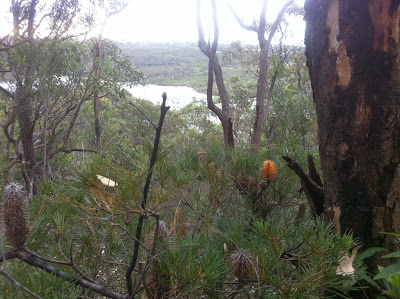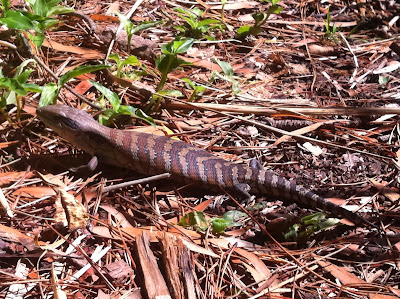The
best trees of, course, are the ones that grow in intact native forests,
supporting complex ecosystems ...and their conservation is of premium
importance. Tragically, Australia’s government wants World Heritage listing for
Tasmania’s iconic forests to be revoked so they can be logged. Tassie's Forests ; they
allow Victoria’s fragile forests to be pulped to make Reflex Paper. Ethical Paper Campaign; whilst majestic Karri and Jarrah forests in Western Australia continue to fall. Logging in W.A.
But if you live in a city environment, the “urban forest” is pretty significant too.
In my suburban street at Manly Vale, Sydney, the community has planted a 1.5 km avenue of native trees and shrubs alongside a moderately busy road called King St. This was done with the assistance of a NSW government grant and it is now maintained by volunteers.
We did this because we wanted to plant species that were endemic specifically to this area and to help replace some of the biodiversity that was missing from the street (and most other local streetscapes).
But if you live in a city environment, the “urban forest” is pretty significant too.
In my suburban street at Manly Vale, Sydney, the community has planted a 1.5 km avenue of native trees and shrubs alongside a moderately busy road called King St. This was done with the assistance of a NSW government grant and it is now maintained by volunteers.
We did this because we wanted to plant species that were endemic specifically to this area and to help replace some of the biodiversity that was missing from the street (and most other local streetscapes).
It was hoped maybe that the species chosen could be a template
for other street plantings (where, traditionally, foreign or “out of area”
species were selected). Native
trees grown from locally sourced seeds, are naturally already suited to our soil
and weather conditions and won’t escape into our bushland areas as invasive
weeds.
Unfortunately a new plan by Warringah Council to plant trees in a few selected streets contains a significant proportion of “exotic” trees (some invasive weed species) and numerous natives not local to our region. Warringah Council Tree Plan This isn’t exactly following the “Landcare ethos”
The avenue was also planted as memorial “avenue of honour” to pay tribute to the service and sacrifice of Merchant Navy personnel in two world wars. Often, these servicemen were not included in other traditional war memorial settings. Avenue of Honour
Unfortunately a new plan by Warringah Council to plant trees in a few selected streets contains a significant proportion of “exotic” trees (some invasive weed species) and numerous natives not local to our region. Warringah Council Tree Plan This isn’t exactly following the “Landcare ethos”
The avenue was also planted as memorial “avenue of honour” to pay tribute to the service and sacrifice of Merchant Navy personnel in two world wars. Often, these servicemen were not included in other traditional war memorial settings. Avenue of Honour
 |
| A stone monument to the Merchant Navy acts as a centrepiece in Kings Reserve. |
 |
| The species planted are endemic to the suburb of Manly Vale, NSW. On the left is a Banksia Serrata (Old Man Banksia) on the right is a Banksia Marginata (Silver Banksia) |
All
this was important..but it seems that the value of street
plantings far exceeded our wildest expectations.
Here
is a selection of the additional benefits that planting, or preserving, urban trees can bring.
1/
Shade provided by urban trees can cool buildings by up to 20 degrees in the
summer.
2/
A single tree can produce a day’s oxygen for four people.
3/ In one day a large tree can remove up to 380
litres of water from the ground and release it into the air.
4/
A tree living for 50 years will generate $62,000 worth of pollution control
plus increase soil fertility and control soil erosion to the tune of $31, 250.
It will also generate $31, 250 worth of oxygen, recycle $37,500 worth of water
and provide a home to animals worth $31, 250. In total, one tree is worth $193,
250 (Professor T.M.Das, The University of Calcutta).
5/ Research has
found that motorists slow down whilst travelling through a tree lined portion
of a street as drivers tend to go more
slowly when something is in their peripheral vision. (Texas A and M)
6/
According to the real estate sector, tree
lined streets can add $15-25,000 of value
to homes and businesses versus non tree comparable streets.
7/
Studies conducted in California show that shade from urban trees can add 40% to
60% more life to road and pavement surfaces through the benefits of shading.
8/
Trees create a safer walking environment by providing distinction between road
edges.
9/
Trees create more pleasant walking environments, provide a sense of place and
encourage more pride, ownership and care in (and of) an area.
10/
Businesses on treescaped streets show 20% higher income streams.
11/
Trees reduce storm water run-off and flooding by absorbing water
12/
Trees provide protection from rain, sun and heat.
13/
Trees absorb car and truck exhaust pollution including carbon monoxide, nitrogen
oxides, organic compounds and particulate matter which add to asthma and other
health impacts. They also convert harmful gasses back into oxygen.
14/
A properly shaded urban street can reduce energy bills for a household by 15%
to 35%.
15/
Trees convert streets, parking areas and walls into more aesthetically pleasing
environments and act as a screen and filter of "visual pollution".
16/
Trees reduce blood pressure and improve emotional and psychological health.
They have a calming effect on ADHD effected adults and teens.
17/
There is compelling evidence to suggest that motorist ‘road rage’ is less in
green urban environments compared to stark urban areas.
18/
Research has shown that healthy street trees help
lessen the levels of domestic violence.
19/ An analysis of numerous studies in BMC Public Health found evidence for street trees having "direct and
positive impacts on well-being," in the form of reduced anger and sadness.
Getting people actively
involved in the planting process makes communities even happier.
20/ A Dutch study suggests every 10% increase in
green space can postpone health complaints in communities by five years. And a US
study is suggests patients that have a view of nature through hospital windows
recover better after surgery.
21/ Street Trees
help improve biodiversity as as
tree-lined streets provide wildlife corridors for birds, animals and insects to
travel. In Australia, “hollow
bearing’ trees are vital in creating homes for arborial marsupials, bats and
birds.
22/
Dutch researchers at VU University discovered that even
glimpsing “green” through a dingy urban window can push the brain to consider
the long-term future. People who watch plants grow exhibit better spending
impulse control. Inner-city girls with views of green space from their window
have proved more adept at concentration, impulse inhibition, and delay of
gratification.
Why
not contact your local Council for assistance and plant endemic native species
from your own specific environment in your
street ! If you live on Sydney sandstone country..the one below would be perfect!













































